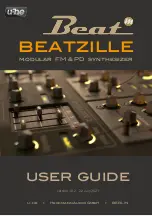
-158-
Ohm’s Law
The relationship between
voltage, current, and
resistance.
Ohm, (
Ω
)
The unit of measure for
resistance.
Oscillator
A circuit that uses feedback to
generate an AC output.
Parallel
When several electrical
components are connected
between the same points in the
circuit.
Pico- (p)
A prefix used in the metric
system. It means a millionth of
a millionth (0.000,000,000,001)
of something.
Pitch
The musical term for frequency.
Printed Circuit Board
A board used for mounting
electrical components.
Components are connected
using metal traces “printed” on
the board instead of wires.
Receiver
The device which is receiving a
message (usually with radio).
Resistance
The electrical friction between
an electric current and the
material it is flowing through;
the loss of energy from
electrons as they move
between atoms of the material.
Resistor
Components used to control
the flow of electricity in a circuit.
They are made of carbon.
Resistor-Transistor-
A type of circuit
Logic (RTL)
arrangement used to construct
digital gates.
Reverse-Biased
When there is a voltage in the
direction of high-resistance
across a diode.
Saturation
The state of a transistor when
the circuit resistances, not the
transistor itself, are limiting the
current.
Schematic
A drawing of an electrical circuit
that uses symbols for all the
components.
Semiconductor
A material that has more
resistance than conductors but
less than insulators. It is used
to construct diodes, transistors,
and integrated circuits.
Series
When electrical components
are connected one after the
other.
Short Circuit
When wires from different parts
of a circuit (or different circuits)
connect accidentally.
Silicon
The chemical element most
commonly used as a
semiconductor.
Speaker
A device which converts
electrical energy into sound.
Switch
A device to connect (“closed” or
“on”) or disconnect (“open” or
“off”) wires in an electric circuit.
Transformer
A device which uses two coils
to change the AC voltage and
current (increasing one while
decreasing the other).
Transient
Temporary. Used to describe
DC changes to circuits.
Transistor
An electronic device that uses
a small amount of current to
control a large amount of
current.
Transmitter
The device which is sending a
message (usually with radio).
Tuning Capacitor
A capacitor whose value is
varied by rotating conductive
plates over a dielectric.
Variable Resistor
A resistor with an additional
arm contact that can move
along the resistive material and
tap off the desired resistance.
Voltage
A measure of how strong an
electric charge across a
material is.
Voltage Divider
A resistor configuration to
create a lower voltage.
Volts (V)
The unit of measure for voltage.
Содержание EP-130
Страница 11: ... 11 I ENTERTAINMENT CIRCUITS ...
Страница 26: ... 26 II BASIC SEMICONDUCTOR AND COMPONENTS CIRCUITS ...
Страница 36: ... 36 III LED DIGITAL DISPLAY CIRCUITS ...
Страница 41: ... 41 IV A TOUR THROUGH DIGITAL CIRCUITS ...
Страница 49: ... 49 V MORE ADVENTURES WITH DIGITAL CIRCUITS ...
Страница 64: ... 64 VI THE WORLD OF TRANSISTOR TRANSISTOR LOGIC ...
Страница 77: ... 77 VII APPLICATION CIRCUITS BASED ON THE OSCILLATOR ...
Страница 88: ... 88 VIII BASIC OPERATIONAL AMPLIFIER CIRCUITS ...
Страница 116: ... 116 IX MORE ADVENTURES WITH OPERATIONAL AMPLIFIERS ...
Страница 129: ... 129 X COMMUNICATION CIRCUITS ...
Страница 136: ... 136 XI TESTING AND MEASURING CIRCUITS ...



























